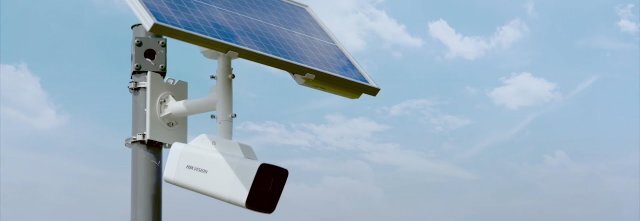Solar Power Systems for Oil & Gas Well Pads and Remote Production Sites

Send us your camera and network gear list and we’ll match it to a 10–500 W solar power package sized for 3–7 days of autonomy.
- IP & PTZ cameras
- LTE / radio links
- Remote gates & yards
Remote oil & gas sites rarely have grid service, and running utility lines is usually slow, costly, or impossible. Our off-grid solar systems keep RTUs, radios, chem pumps, and instrumentation running reliably 24/7 -- without trenching, generator fuel runs, or utility delays.
Why Oil & Gas Sites Struggle With Reliable Power
Remote production sites often operate far beyond utility reach, and even when power is available, voltage drops, long feeder runs, and weather-related outages can interrupt critical field data. Trenching in new service is slow and expensive, and generator setups mean fuel runs, maintenance cycles, and unexpected downtime.
A properly sized off-grid solar package removes these headaches by keeping your RTUs, radios, flow computers, chem pumps, and instrumentation online 24/7 -- without waiting on utilities or sending crews back into the field.
Typical Equipment Loads on Oil & Gas Sites
Representative power and energy use for common oil & gas field devices.
| Equipment | Typical Power (W) | Daily Energy (Wh) | Notes |
|---|---|---|---|
| RTU / Flow Computer | 3–10 W | 70–240 Wh/day | Base load for most pads and valve sites. |
| PLC Panel | 5–20 W | 120–480 Wh/day | Depends on I/O count and comms hardware. |
| Licensed / Unlicensed Radio | 3–10 W | 70–240 Wh/day | Higher when TX duty cycle is heavy. |
| LTE / Cellular Gateway | 5–12 W | 120–300 Wh/day | Varies with signal strength and backhaul. |
| Chemical Injection Pump (low power) | 10–40 W avg | 240–960 Wh/day | Highly duty-cycle dependent. |
| Instrumentation (P/T/Level) | 1–5 W total | 24–120 Wh/day | Most transmitters are sub-watt; radios dominate. |
| CP Monitoring and Telemetry | 2–8 W | 50–190 Wh/day | Includes data logger and comms. |
Oil & Gas Load & Solar Sizing Helper
Enter your typical device loads below to get a ballpark solar array and battery size. This tool is for planning and kit selection only -- final designs are reviewed against your site conditions and standards.
Where Oil & Gas Loads Fit in Our Standard 10–500 W Kits
Most oil & gas sites fall into the same kit classes we use for other industrial telemetry and control loads. The difference is how you combine RTUs, radios, chem pumps, and instrumentation on each pad or valve station.
- 10–50 W kits — single RTU or flow computer with a small radio.
- 50–150 W kits — RTU/PLC plus LTE or higher-duty radios and sensors.
- 150–300 W kits — chem pump + RTU + radio combinations and multi-panel cabinets.
- 300–500 W kits — larger skids and multi-load sites with higher telemetry duty cycles.
For full details on array sizes, battery banks, and how these kits apply to other industries like security, water, and remote telemetry, see our standard kit overview:
Off-Grid Solar Kits: 10–500 W Standard Ranges →
Already Have Preferred Fabricators? Build from Stock Components.
If you’re working with existing skid or panel vendors, we can supply the solar side: modules, charge controllers, batteries, and mounting hardware sized to your drawings. Many operators standardize on just a few SKUs they can deploy across hundreds of sites.
- Solar panels 10–500 W for poles, skids, and small structures.
- PWM & MPPT charge controllers matched to your array and battery bank.
- AGM and sealed batteries sized for autonomy and service intervals.
- Mounting hardware for pipe racks, small structures, and freestanding poles.
For a broader overview of how these pieces fit together across industries, see our component summary:
Industrial Off-Grid Solar Components → (coming soon)
Want to See the Sizing Math?
Oil & gas loads are sized using the same method we apply to other industrial DC systems: daily watt-hours, site sun hours, realistic derates, and a target autonomy window. We document that approach in detail and provide a calculator you can experiment with.
Oil & Gas Solar FAQ
How many days of autonomy do I need at a remote well pad?
Many operators target 3–5 days of autonomy depending on climate and site access. Critical sites, or those with difficult winter access, may call for 7+ days. We’ll match autonomy to your operations and maintenance plan.
Can these systems support chemical injection pumps?
Yes — especially low-power, intermittent-duty pumps. The key is understanding the true average power draw over a full day so we can pick the right kit class and battery bank. If your pump profile changes seasonally, we can design for that too.
Do you support hazardous-area requirements?
Many oil & gas locations require hazardous-area rated equipment. We can help you pair solar power packages with appropriate field devices and enclosures that meet your site requirements and corporate standards.
What if my load profile changes later?
We can plan for reasonable growth — adding radios, transmitters, or small pumps — by reserving array and battery margin. For major upgrades, we’ll help you re-run the sizing and adjust kit class as needed.


